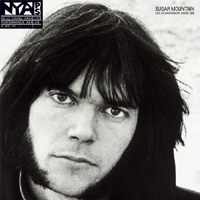Think of the possibilities. You’re sitting in a small venue called the Canterbury House in Ann Arbor, Michigan. It’s operated by the Episcopal Diocese of Michigan as a ministry to University of Michigan students, faculty and staff. It’s 1968, and a young man with a guitar takes the stage. You may have no idea that you’re sitting in the presence of greatness, even after the young man starts playing. It’s all too intimate and comfy and the man is a regular chatterbox with all these inane little anecdotes he tells between songs. This was a 22-year-old Neil Young working out the kinks in his solo act by taking the barren route with an acoustic, his voice and a bar stool. And these early performances were wisely captured on a TEAC two-track tape recorder and put away, only to be picked over the intervening years, and 40 years later finally released as Sugar Mountain Live At Canterbury House 1968, as part of the continuing Neil Young Archive Performance Series.
The 23-track disc features tunes from both nights. Young not only dazzles the audience with the title track, but dips into a bag tricks with an array of Buffalo Springfield oldies — “On The Way Home,” “Mr. Soul” and a dramatic “Expecting To Fly.” Then he pulls out one from his self-titled debut, unquestionably one of Young’s most Dylanesque performances, “The Last Trip To Tulsa.” This is where the man’s gift to mesmerize an audience with a simple, sometimes clumsy melody wrapped in a riddle comes to light. Before launching into “The Loner,” Young feels compelled to share a story about a job he had a bookstore in Toronto. “I was fired,” he said before asking, “Everyone here is OK, right? There’s no cops in here, right?” You can imagine where it goes from there.
“The Loner,” of course, takes on a life of its own, eventually laying the groundwork for so much more to come. An early take of “Birds,” which found its way on After The Gold Rush, is gentle and confident. Young exhibits that same stroke of poise throughout. And you begin to understand how he became what he is today. It isn’t flashy or self-serving; it’s Young’s effacing, spontaneous manner that works to his advantage, adding a certain edge, focus and rapture surrounding his songs. It works on old Springfield chestnuts like “Out Of My Mind” and “Nowadays Clancy Can’t Even Sing,” and just as easily on newer (in 1968) tunes like “Winterlong” (maybe a snippet) “If I Could Have Her Tonight” and “I’ve Been Waiting For You.”
After “The Old Laughing Lady” aimlessly falls into “Broken Arrow,” which itself is a very broken tune (in a good way), Young’s grip, sway and charming good hooks are on full display. He would, of course, make the albums, play with CSN, Crazy Horse and an odd and wonderful assortment of other combinations, collaborations, one-offs, or occasionally all by himself. Young’s lonely road trips are far and few between, so to hear how it all sort of fissured and meshed together is a tempting offer. As a Performance Series item, the recording will not be part of the 10-Blu-ray disc box set. All the more why this Sugar Mountain Live At Canterbury House 1968 is a CD (or DVD-A) made for the spin cycle.
~ Shawn Perry




















